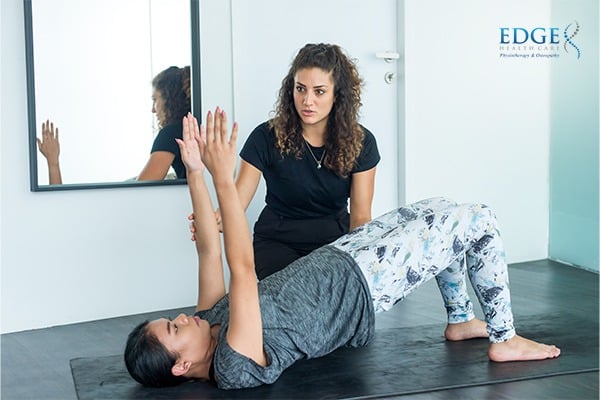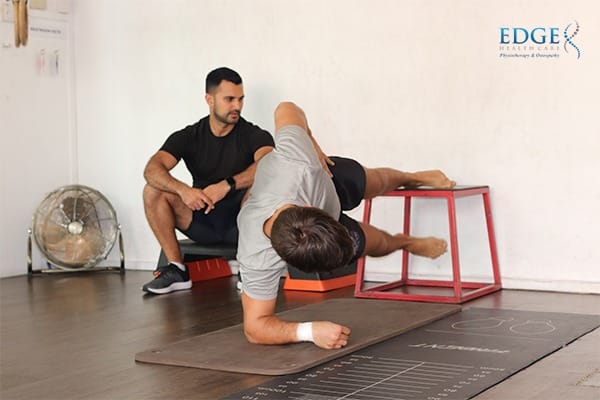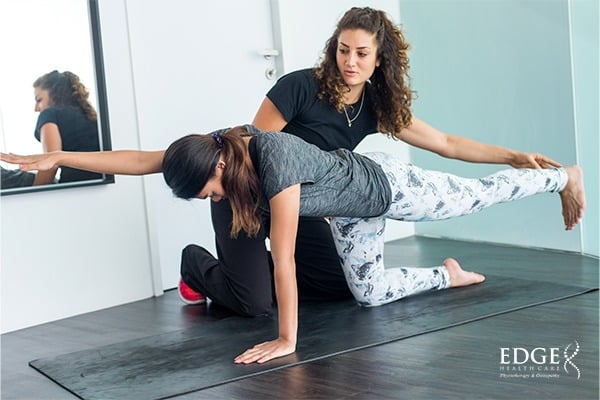
Are injuries restricting your usual movement and preventing you from partaking in your daily activities? In these instances, your physiotherapist may recommend Clinical Pilates to help with longer-term compensatory movement patterns and alleviate chronic pain. However, what separates Clinical Pilates from Traditional Pilates offered by various fitness centres in Singapore?
Despite sounding like two sides of the same coin, both exercise programmes feature several distinctions in practice, purpose, and methods. Of course, we understand it can be puzzling to wrap your head around these two interrelated concepts. That is why we are examining the vital differences between the two exercise methods so that you have a better understanding of the subject.
Difference #1: Purpose and focus

Pilates, as it was developed by Joseph Pilates, a professional dancer, was originally intended to promote overall fitness, flexibility, and body conditioning. As an overview, Pilates utilises a person’s body weight or the resistance of the equipment, in combination with movement and breath control, to improve strength and agility.
This form of Pilates is probably the one you are more familiar with, as it caters to the general public and does not focus on any injury or physical need. Instead, the aim is to improve overall physical health and well-being by developing core stability, enhancing muscular balance, and promoting efficient movement patterns.
Conversely, while Clinical Pilates builds on the same principles, it is an adaptation focused on rehabilitation and injury prevention. Often used in conjunction with physical therapy, it involves a more individualised approach by considering a person’s specific injuries and physical needs rather than having multiple individuals complete the same programme.
Difference #2: Instructor qualifications

In Traditional Pilates classes, instructors can guide you through a range of exercise programmes, including basic mat and comprehensive apparatus training. However, they may not be qualified to provide clinical or rehabilitative guidance as they lack expert knowledge and training in exercise physiology and pathology.
Meanwhile, Clinical Pilates is carried out by instructors with additional training in rehabilitation – usually physiotherapists. Because these instructors possess a deeper understanding of anatomy, injury management, and rehabilitation principles, they can provide a clinical assessment of your condition and tailor the programme with suitable exercises that improve and address your concern while minimising the risk of aggravating your injury.
Difference #3: Integration of rehabilitation principles

As we shared earlier, Traditional Pilates primarily focuses on fitness and general body conditions. Exercises conducted during the classes are basic and aimed towards a group rather than personalised for the individual. As such, there is a lack of consideration for rehabilitation, making it unsuitable for those with special requirements or injuries. You may even aggravate your condition since the correct form is not enforced.
In contrast, Clinical Pilates is led and supervised by a physiotherapist with proper training. Equipped with their knowledge of bodily function, movement patterns, and injury prevention, a physiotherapist knows how to integrate rehabilitation principles to aid in recovery, combining the principles of Pilates with evidence-based practices from physical therapy.
Throughout the exercise programme, the instructor will closely observe your techniques and utilisation of specific Pilates equipment to ensure safe use and correct form. Your progress will also be monitored to help you achieve the desired results. This level of personalisation sets Clinical Pilates apart as a therapeutic exercise method.
Learn More: 4 Reasons To Seek Physiotherapy
Deciding between Traditional Pilates and Clinical Pilates boils down to how you feel about your body. The former offers a general approach to overall fitness and well-being. As such, it will suffice if your goal is to strengthen your body or improve flexibility and stability. However, the latter is more suitable if you are struggling with a musculoskeletal injury, as it prioritises rehabilitation, injury prevention, and individualised treatment.
So assess your specific goals beforehand to ensure you make an informed decision that meets your needs. If you are unsure, do not hesitate to consult our physiotherapists, who can provide you with the most suitable exercise methods to promote optimal health and wellness. Contact us to schedule an appointment with our physiotherapy clinic today!
What is Clinical Pilates?
Clinical Pilates is a form of treatment exercise that focuses on making your body stronger and healthier. Breathing, posture, strength, flexibility, balance, and core stability are key points of emphasis. It is a form of exercise that works every major muscle in your body.
Pilates is a popular treatment option for a variety of issues, particularly those involving the neck and back. Studies indicate it is very effective in treating injuries, particularly lower back ailments. Clinical Pilates targets your body’s key stabilising muscles, contributing to improved core stability.
What is the Difference Between Regular Pilates and Clinical Pilates?
- Regular Pilates
- Usually guided by a Pilates-trained instructor or personal trainer
- No customised fitness routines
- Ideal for enhancing general flexibility, fitness, and core strength.
- Usually in classes with larger groups
- Clinical Pilates
- It is led by a medical expert who has knowledge of injuries, such as a physical therapist, physiotherapist, or other recognised healthcare specialist.
- It offers customised workout plans depending on each person’s unique demands and problems (such as persistent back discomfort or a knee injury)
- A full assessment determines the body’s preferred mobility pattern, restrictions, goals, and history of injuries.
- Treatment with physiotherapy may be included in the programme.
- If an injury recurs, specific adjustments can be made to the Clinical Pilates programme.
- Optimal recovery from an injury, surgery, or pregnancy that also minimises musculoskeletal pain by addressing improper body mechanics.
- Sessions in private or small groups
Benefits of Pilates
Clinical Pilates has several advantages and can help people achieve a variety of physical fitness objectives.
- Pain Management
- Injury Rehabilitation
- Enhances Mobility Including Agility and Flexibility
- Supports Athletes in Training and Injury Prevention
- Helps Older Adults Maintain Movement and Live Pain-Free
- Fantastic For Pre- and Post-Natal Care
How Does Clinical Pilates Help?
Clinical Pilates involves instructing individuals on achieving a neutral spine and strengthening their deep muscles. As they grasp proper sitting or standing posture, they gradually develop a stronger back. Through consistent practice, individuals enhance their endurance, sustaining improved postures for longer durations. Commencing with personalized physiotherapy sessions or small-group courses is strongly recommended, particularly for novices. This ensures accurate instruction on the fundamental principles of Pilates: breathing, neck, rib, pelvic position, and stabilization. Given the potential challenges and risks of incorrect execution, close supervision is essential to prevent the reinforcement of improper movement patterns.
What Can Pilates Treat?
Numerous physical health conditions can find therapeutic benefits from clinical Pilates, such as:
- Spinal pain management and prevention
- Post-surgery or traumatic injury rehabilitation
- Osteoporosis and arthritis management
- Balance retraining
- Chronic pain
- Sports-related strength and conditioning
- Hypermobility disorder
- Enhancing agility and flexibility
- Prenatal, antenatal, and postnatal conditioning
- General fitness and muscle training
- Muscle toning and improved core strength
- Better posture and flexibility


